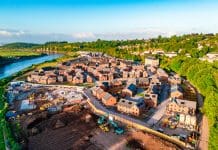A new digital prototype has been launched at MIPIM UK, demonstrating the potential of bringing together land, planning and housing data from different government agencies, all in one place
As part of a planning pilot commissioned by the Department for Communities and Local Government (DCLG), Future Cities Catapult set out to design future tools to help speed up, reduce the costs and improve the quality, of plan-making and planning decisions.
The ‘Land Information Platform’ aims to help planners, real estate developers and citizens, to identify and prioritise land for future development – accelerating the allocation of land for new development, predicting development capacity and estimating development costs. In the future, planning tools will automate a variety of existing processes, freeing up planners time, reducing the costs to the public of planning, and creating a more transparent system for the benefit of smaller developers and citizens.
Stefan Webb, Head of Projects at Future Cities Catapult said:
“We are very excited about the disruptive nature of this pilot, and its potential to be a trailblazer for how data and digital tools can support planners, developers and citizens.
“With the government’s manifesto commitment to create ‘the largest repository of open land data in the world’, the Land Information Platform demonstrates one of the ways in which public information can be used to accelerate the development process, increase certainty, and improve transparency.
“We believe open-source public data platforms can support an eco-system of new software for planning, much like the app store, allowing others to build digital products and services on top of this system, replacing time-consuming, expensively produced consultant reports that lie unread by man or machine.”
Richard Blyth, Head of Policy at the Royal Town Planning Institute said:
“Local Planning Authorities would greatly benefit from new digital tools which help them to collect and aggregate land and planning data. This prototype shows the art of the possible, and it’s great that the Department for Communities and Local Government are looking into this.”
The prototype demonstrates how critical parts of local plan-making such as land identification, prioritisation and site allocations for development can be automated, speeding up and increasing certainty around housing capacity, Strategic Housing Land Availability Assessments (SHLAA) or other similar processes.
By using a variety of dataset from Ordnance Survey and Land Registry, as well as historic planning data and open government information such as energy performance certificates, the tool would automatically screen and identify potential development opportunities.














